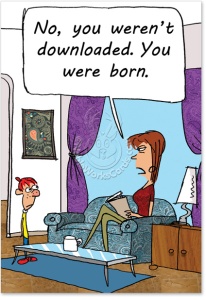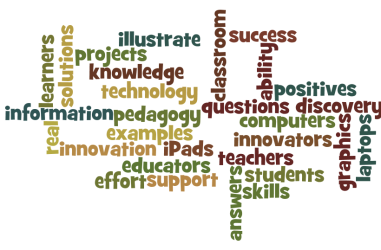Sample Of MY Own Marking
Friday, May 8th, 2015Sample Of My Peer Marking
Thursday, May 7th, 2015Evaluation Matrix 2
Sunday, May 3rd, 2015Evaluation Matrix 1
Sunday, May 3rd, 2015Scooped by Lulu Fazzino
onto Early childhood education
What is a Digital World?
Saturday, May 2nd, 2015Fazzino_ L _17642761_ Assessment 2_ EDUC 1000
What is a Digital World?
Generation Z and Generation ALPHA the Digital Natives. Generation Z is those born between 1995 and 2009 they are known as the Digital Integrators while Generation ALPHA are born from 2010; they have just begun their schooling years. They are the children of the 21st century, born into a digital world. Howell, (2014). Even for a digital Immigrate such as myself, I have had to skill up myself in becoming digitally fluent, even though I can navigate myself through a website, I still have a lot to learn because technology is forever changing. I am aware that I need to continuously upgrade my knowledge and understanding of technology in general.
http://www.youtube.com/watch?v=UFwWWsz_X9s
Parents are entertaining their children with technology for recreational use; young children can be observed in strollers, shopping centers, cars, etc. playing on the iPad or the mobile phone. Technology has become a bargaining tool for parents. I know my daughter tells her 6-year-old daughter that she will be banned from playing on her iPad unless she does as she is told. Children are entranced with technology from a very young age and by the time they enter school they have a sound knowledge of what technology can offer.
Schools are equipped with technology, and teachers are up skilled in delivering lessons relevant to the learning. Interactive whiteboards hold a fascination for young children, and because it has the interactive component they are called upon to show their understanding of the lesson put before them. Computers and iPad are a powerful learning tool for children at school. Constructivism is a theory of knowledge and as Piaget suggests that, through with the processes of Accommodation and Assimilation, individuals construct new knowledge from their experiences children take what they already know about technology and apply it to new learning experiences. (Howell. 2014).

References
The History Of Technology In Education (3 October 2011). Retrieved From http://www.youtube.com/watch?v=UFwWWsz_X9s
Son You Weren’t Downloaded Mother’s Day Greeting Card (30 October 2014). (Image) Retrieved from www.nobleworkscards.com
Howell, J. (2012) Teaching with ICT: digital pedagogies for collaboration & creativity.
South Melbourne, Victoria: Oxford University Press.
Digital Fluency
Saturday, May 2nd, 2015Educators in a classroom are striving towards teaching students to become digitally fluent. Children enter their early years of schooling with a basic knowledge of how computers and digital technology works.
Young children are more fluent with gaming skills such as PlayStation, Xbox Nintendo and Wii when children enter their first school years they are taught in the classroom the skills to develop through guided play and integrated learning using an iPad to navigate through appropriate learning Apps. There is a considerable amount of Apps available, which are suitable for early years; teachers need to upload the appropriate applications to support students learning. As children progress through their schooling years so does their ability to navigate, explore and become innovative thinkers through guided lessons students are able to experiment the process of different solutions whether they are researching Australian Animals or interesting facts about Brazil once students have their set goals they can collect information to create an intriguing story. Once the script has been set they are then able to create a movie where they record themselves telling the story, edit the changes necessary, change images to suit their script add voice over and music to their project. All this can be achieved with the support and guidance of a teacher who can encourage students and provide feedback so they can keep trying. As students progress through school, they become more proficient with technology and have a more solid understanding of how the technology works because they can adapt, use and create information.
In order to develop my digital pedagogy, I would guide students to become technological innovators understand the process of how something works and how to make it work. My understanding of digital fluency is that it’s a gradual process, and we need to give them the strategies to understand the design (Howell, 2014).
References
Howell, J. (2012) Teaching with ICT: digital pedagogies for collaboration & creativity. South Melbourne, Victoria: Oxford University Press.
The Digital Divide
Saturday, May 2nd, 2015In recent years, the Internet has imploded in our daily lives whether we use it for entertainment and personal pleasure or whether we use it in our professional lives, including school and education. The Internet has become a necessary evil. We’re living in a world where it is expected for us to be able to use digital technology it is no longer limited to a desktop we now carry the Internet around everywhere we go (Howell. 2014).
I know from my personal experience if I am driving to work and realise I have left my mobile at home I will turn the car around and go and pick it up I could not imagine walking around without my mobile in my pocket, it has become so easy to check my emails, messages, notes that I may have written throughout the night and easy access to my family and friends anywhere in the world. How did we survive so many years ago without mobile Internet, I struggle to remember.
There are concerns that there is a digital divide in regional Australia, Internet access is not readily available and there is a long wait time before they do get connected, cost is also a factor lower socio-economic families find it difficult to justify paying a monthly bill to stay connected. Even though, there is talk about National Broadband Network providing high- speed Internet through a combination of mobile and satellite networks. Even when Internet becomes available to our Indigenous and Rural communities they need to have the support in order to use the technology provided it is not as simple as connecting to the Internet. Knowing how technology keeps us connected to the world, it is sad that many communities are missing out in such an experience because of lack of connection or knowledge.
Source: ABS 2006 Census of Population and Housing.
References
Australian Bureau of Statistics. (2008).
Internet Access At Home. Retrieved from http://abs.gov.au/AUSSTATS/abs@.
nsf/Lookup/4102.0Chapter10002008
Howell, J. (2012) Teaching with ICT: digital pedagogies for collaboration & creativity. South Melbourne, Victoria: Oxford University Press.
